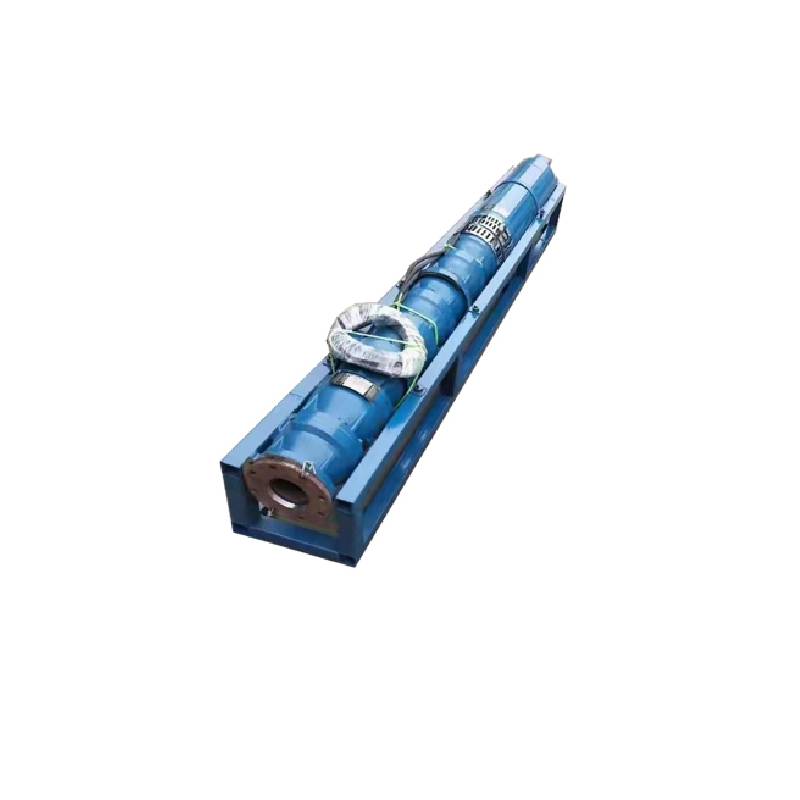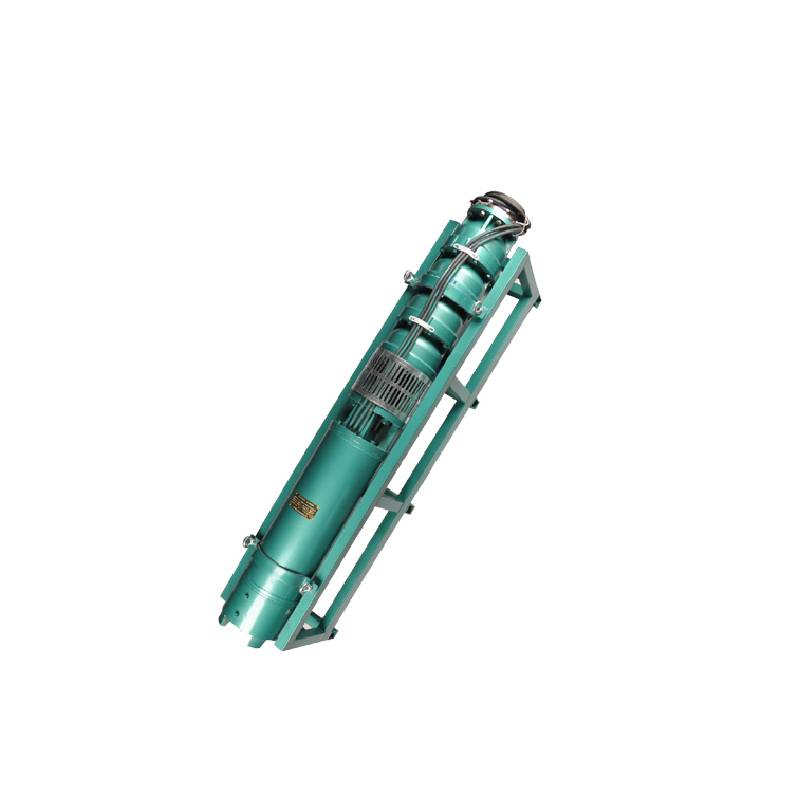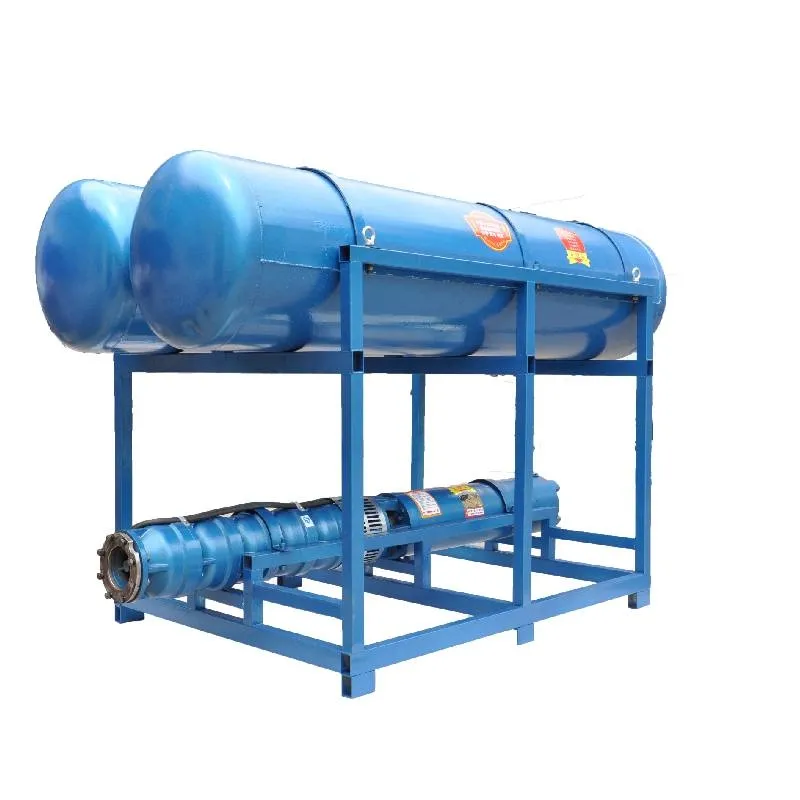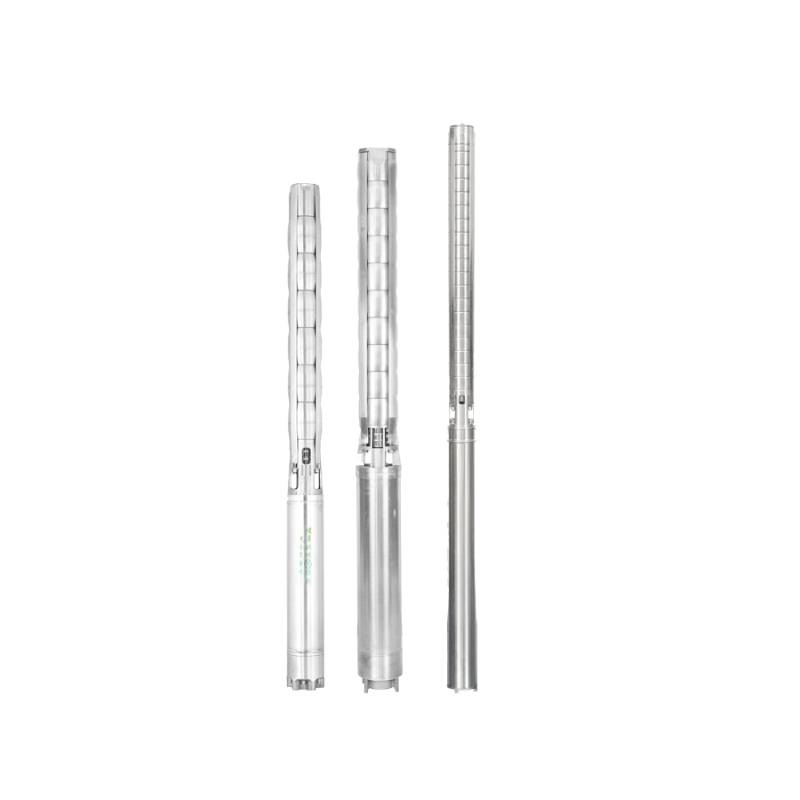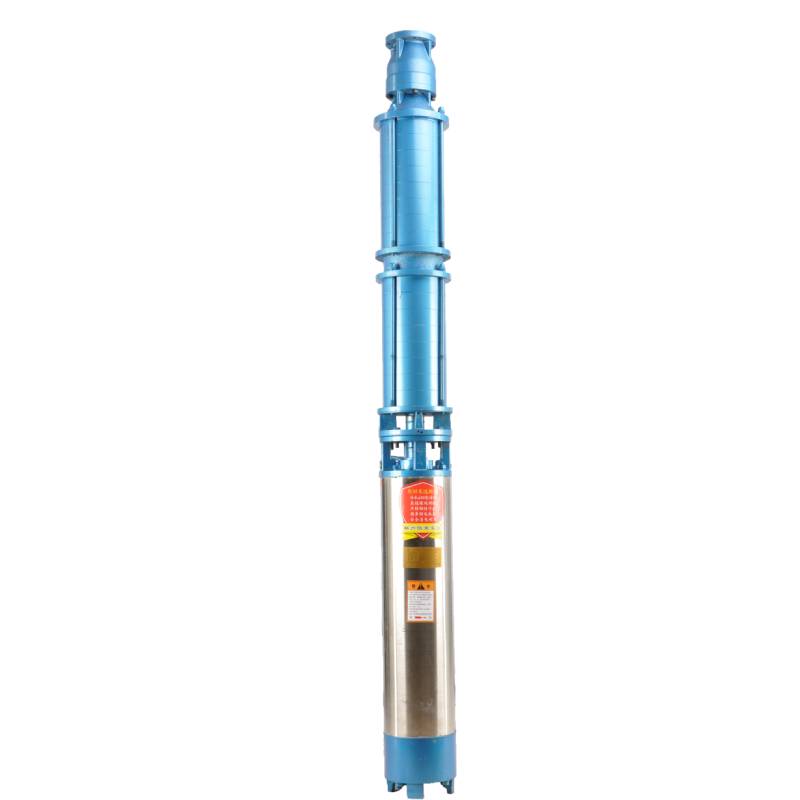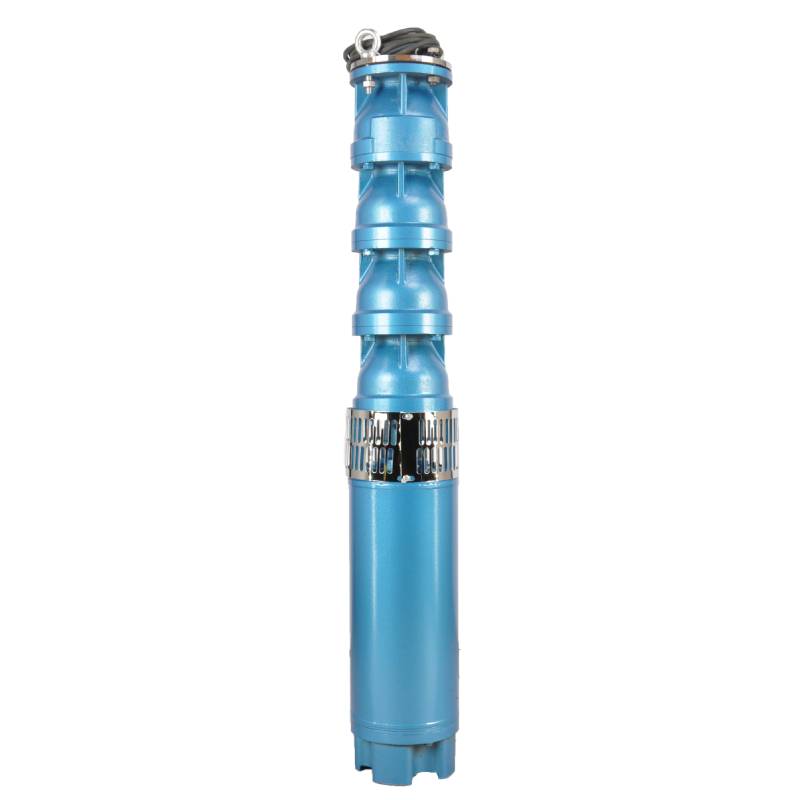This series of fountain pump is a special fountain pump developed by our factory. The pump motor core is made of high quality cold rolled silicon steel, which makes the pump more efficient, has good magnetic conductivity, and does not produce heat when starting frequently. The two ends of the motor rotor are equipped with alloy copper sleeves with water as lubricant. Stainless steel bushings replace ball bearings, avoiding the problems of easy rust of ball bearings and burnout of motor due to lack of oil and wear. Most suitable for music fountain, all models can be used horizontally.
1, bekalan kuasa: tiga fasa AC 380V (toleransi + / - 5%), 50HZ (toleransi + / - 1%).
2, kualiti air:
(1) water temperature is not higher than 20 °C;
(2) kandungan kekotoran pepejal (nisbah jisim) tidak melebihi 0.01%;
(3) Nilai PH (pH) 6.5-8.5;
(4) kandungan hidrogen sulfida tidak melebihi 1.5mg/L;
(5) kandungan ion klorida tidak melebihi 400mg/L.
3, motor ditutup atau struktur basah yang dipenuhi air, sebelum menggunakan rongga motor tenggelam mesti penuh dengan air bersih, untuk mengelakkan penuh palsu, dan kemudian ketatkan suntikan air, bolt pelepas udara, jika tidak, tidak dibenarkan menggunakan
4, pam tenggelam mesti tenggelam sepenuhnya di dalam air, kedalaman menyelam tidak lebih daripada 70m, bahagian bawah pam tenggelam dari bahagian bawah telaga tidak kurang daripada 3m.
5, aliran air telaga harus dapat memenuhi keluaran air pam tenggelam dan operasi berterusan, keluaran air pam tenggelam harus dikawal pada 0.7 - 1.2 kali aliran undian.
6, telaga harus lurus, pam tenggelam tidak boleh digunakan atau dibuang, hanya penggunaan menegak.
7, pam tenggelam mesti dipadankan dengan kabel mengikut keperluan, dan peranti perlindungan beban luaran.
8, pam adalah dilarang sama sekali tanpa mesin ujian tanpa beban air
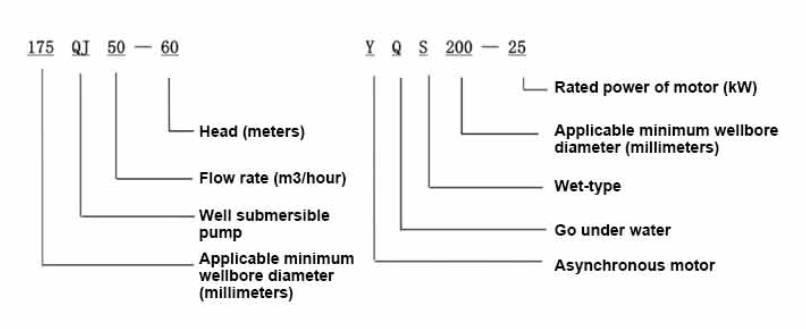
| Model | Aliran (m3/j) | kepala (m) |
Kelajuan berputar (ubah/titik) |
Pam air(%) | Outlet diameter (mm) |
Berkenaan dengan baik diameter(mm) |
Dinilai power(KW) |
Dinilai voltan(V) |
Dinilai semasa (A) |
Kecekapan motor (%) | power factorcosφ | Unit Saiz Maksimum Jejari (mm) |
Teguran | |||||||||
| 250QJ50-40 | 50 | 40 | 2875 | 72 | 80 | 250atas | 9.2 | 380 | 21.7 | 78.5 | 0.82 | 233 | ||||||||||
| 250QJ50-60 | 60 | 13 | 30.1 | 80.0 | 0.82 | |||||||||||||||||
| 250QJ50-80 | 80 | 18.5 | 40.8 | 82.0 | 0.84 | |||||||||||||||||
| 250QJ50-100 | 100 | 22 | 47.9 | 83.0 | 0.84 | |||||||||||||||||
| 250QJ50-120 | 120 | 25 | 53.8 | 84.0 | 0.84 | |||||||||||||||||
| 250QJ50-140 | 140 | 30 | 64.2 | 84.5 | 0.84 | |||||||||||||||||
| 250QJ50-160 | 160 | 37 | 77.8 | 85.0 | 0.85 | |||||||||||||||||
| 250QJ50-200 | 200 | 45 | 94.1 | 85.5 | 0.85 | |||||||||||||||||
| 250QJ50-240 | 240 | 55 | 114.3 | 86.0 | 0.85 | |||||||||||||||||
| 250QJ50-280 | 280 | 63 | 131.0 | 86.0 | 0.85 | |||||||||||||||||
| 250QJ50-320 | 320 | 75 | 152.3 | 87.0 | 0.86 | |||||||||||||||||
| 250QJ50-400 | 400 | 90 | 182.8 | 87.0 | 0.86 | |||||||||||||||||
| 250QJ50-440 | 440 | 100 | 203.1 | 87.0 | 0.86 | |||||||||||||||||
| 250QJ63-40 | 63 | 40 | 2875 | 74 | 80 | 250atas | 11 | 380 | 25.8 | 79.0 | 0.82 | 233 | ||||||||||
| 250QJ63-60 | 60 | 18.5 | 40.8 | 82.0 | 0.84 | |||||||||||||||||
| 250QJ63-80 | 80 | 22 | 47.9 | 83.0 | 0.84 | |||||||||||||||||
| 250QJ63-100 | 100 | 30 | 64.2 | 84.5 | 0.84 | |||||||||||||||||
| 250QJ63-120 | 120 | 37 | 77.8 | 85.0 | 0.85 | |||||||||||||||||
| 250QJ63-160 | 160 | 45 | 94.1 | 85.5 | 0.85 | |||||||||||||||||
| 250QJ63-200 | 200 | 55 | 114.3 | 86.0 | 0.85 | |||||||||||||||||
| 250QJ63-220 | 220 | 63 | 131.0 | 86.0 | 0.85 | |||||||||||||||||
| 250QJ63-260 | 260 | 75 | 152.3 | 87.0 | 0.86 | |||||||||||||||||
| 250QJ63-300 | 300 | 90 | 182.8 | 87.0 | 0.86 | |||||||||||||||||
| 250QJ63-360 | 360 | 100 | 203.1 | 87.0 | 0.86 | |||||||||||||||||
| 250QJ80-20 | 80 | 20 | 2875 | 75 | 100 | 250atas | 7.5 | 380 | 18.0 | 78.0 | 0.81 | 233 | ||||||||||
| 250QJ80-40 | 40 | 15 | 33.9 | 81.0 | 0.83 | |||||||||||||||||
| 250QJ80-60 | 60 | 22 | 47.9 | 83.0 | 0.84 | |||||||||||||||||
| 250QJ80-80 | 80 | 30 | 64.2 | 84.5 | 0.84 | |||||||||||||||||
| 250QJ80-100 | 100 | 37 | 77.8 | 85.0 | 0.85 | |||||||||||||||||
| 250QJ80-120 | 120 | 45 | 94.1 | 85.5 | 0.85 | |||||||||||||||||
| 250QJ80-160 | 80 | 160 | 2875 | 75 | 100 | 250atas | 55 | 380 | 114.3 | 86.0 | 0.85 | 233 | ||||||||||
| 250QJ80-180 | 180 | 63 | 131.0 | 86.0 | 0.85 | |||||||||||||||||
| 250QJ80-200 | 200 | 75 | 152.3 | 87.0 | 0.86 | |||||||||||||||||
| 250QJ80-240 | 240 | 90 | 182.8 | 87.0 | 0.86 | |||||||||||||||||
| 250QJ80-280 | 280 | 100 | 203.1 | 87.0 | 0.86 | |||||||||||||||||
| 250QJ100-18 | 100 | 18 | 2875 | 75 | 100 | 250atas | 7.5 | 380 | 18.0 | 78.0 | 0.81 | 233 | ||||||||||
| 250QJ100-36 | 36 | 15 | 33.9 | 81.0 | 0.83 | |||||||||||||||||
| 250QJ100-54 | 54 | 25 | 53.8 | 84.0 | 0.84 | |||||||||||||||||
| 250QJ100-72 | 72 | 30 | 64.2 | 84.5 | 0.84 | |||||||||||||||||
| 250QJ100-90 | 90 | 37 | 77.8 | 85.0 | 0.85 | |||||||||||||||||
| 250QJ100-108 | 108 | 45 | 94.1 | 85.5 | 0.85 | |||||||||||||||||
| 250QJ100-126 | 126 | 55 | 114.3 | 86.0 | 0.85 | |||||||||||||||||
| 250QJ100-144 | 144 | 63 | 131.0 | 86.0 | 0.85 | |||||||||||||||||
| 250QJ100-162 | 162 | 75 | 152.3 | 87.0 | 0.86 | |||||||||||||||||
| 250QJ100-198 | 198 | 90 | 182.8 | 87.0 | 0.86 | |||||||||||||||||
| 250QJ100-216 | 216 | 100 | 203.1 | 87.0 | 0.86 | |||||||||||||||||
| 250QJ125-16 | 125 | 16 | 2875 | 76 | 125 | 250atas | 9.2 | 380 | 21.7 | 78.5 | 0.82 | 233 | ||||||||||
| 250QJ125-32 | 32 | 18.5 | 40.8 | 82.0 | 0.84 | |||||||||||||||||
| 250QJ125-48 | 48 | 25 | 53.8 | 84.0 | 0.84 | |||||||||||||||||
| 250QJ125-64 | 64 | 37 | 77.8 | 85.0 | 0.85 | |||||||||||||||||
| 250QJ125-80 | 80 | 45 | 94.1 | 85.5 | 0.85 | |||||||||||||||||
| 250QJ125-96 | 96 | 55 | 114.3 | 86.0 | 0.85 | |||||||||||||||||
| 250QJ125-112 | 112 | 63 | 131.0 | 86.0 | 0.85 | |||||||||||||||||
| 250QJ125-128 | 128 | 75 | 152.3 | 87.0 | 0.86 | |||||||||||||||||
| 250QJ125-160 | 160 | 90 | 182.8 | 87.0 | 0.86 | |||||||||||||||||
| 250QJ125-176 | 176 | 100 | 203.1 | 87.0 | 0.86 | |||||||||||||||||
| 250QJ125-192 | 192 | 110 | 219.6 | 87.5 | 0.87 | |||||||||||||||||
| 250QJ140-15 | 140 | 15 | 2875 | 76 | 125 | 250atas | 9.2 | 380 | 21.7 | 78.5 | 0.82 | 233 | ||||||||||
| 250QJ140-30 | 30 | 18.5 | 40.8 | 82.0 | 0.84 | |||||||||||||||||
| 250QJ140-45 | 45 | 30 | 64.2 | 84.5 | 0.84 | |||||||||||||||||
| 250QJ140-60 | 60 | 37 | 77.8 | 85.0 | 0.85 | |||||||||||||||||
| 250QJ140-75 | 45 | 45 | 94.1 | 85.5 | 0.85 | |||||||||||||||||
| 250QJ140-90 | 90 | 55 | 114.3 | 86.0 | 0.85 | |||||||||||||||||
| 250QJ140-105 | 140 | 105 | 2875 | 76 | 125 | 250atas | 63 | 380 | 131.0 | 86.0 | 0.85 | 233 | ||||||||||
| 250QJ140-120 | 120 | 75 | 152.3 | 87.0 | 0.86 | |||||||||||||||||
| 250QJ140-150 | 150 | 90 | 182.8 | 87.0 | 0.86 | |||||||||||||||||
| 250QJ140-165 | 165 | 100 | 203.1 | 87.0 | 0.86 | |||||||||||||||||
| 250QJ140-180 | 180 | 110 | 219.6 | 87.5 | 0.87 | |||||||||||||||||
| 250QJ200-20 | 200 | 20 | 2875 | 75 | 150 | 250atas | 18.5 | 380 | 40.8 | 82.0 | 0.84 | 233 | ||||||||||
| 250QJ200-40 | 40 | 37 | 77.8 | 85.0 | 0.85 | |||||||||||||||||
| 250QJ200-60 | 60 | 55 | 114.3 | 86.0 | 0.85 | |||||||||||||||||
| 250QJ200-80 | 80 | 75 | 152.3 | 87.0 | 0.86 | |||||||||||||||||
| 250QJ200-100 | 100 | 90 | 182.8 | 87.0 | 0.86 | |||||||||||||||||
| 250QJ200-120 | 120 | 100 | 203.1 | 87.0 | 0.86 | |||||||||||||||||
| 250QJ200-140 | 140 | 125 | 249.5 | 87.5 | 0.87 | |||||||||||||||||
1, well submersible pump for clean water pump, prohibit the new well, pumping sediment and muddy water,
2, well water pump voltage grade of 380/50HZ, the use of other voltage grades of submersible motors need to be customized. The underground cable must use waterproof cable, must be equipped with starting equipment, such as distribution box, start not ready should have commonly used motor comprehensive protection function, such as short circuit overload protection, phase protection, undervoltage protection, grounding protection, idling protection, in case of abnormal conditions, the protection device should be timely action trip.
3, the installation and use of the pump must be reliably grounded, prohibit the push and pull switch when the hands and feet are wet, the installation and maintenance of the pump must be cut off the power supply, the use of the pump place to set up "to prevent electric shock" obvious signs:
4, down the well or before installation, the motor cavity must be filled with distilled water or non-corrosive clean cold boiling water, tighten the / water bolt, the pump on the ground test run, must be to the pump chamber water lubrication rubber bearings, instant start not more than a second, see whether the steering is the same as the steering instructions. When the pump is upright, pay attention to safety, prevent overturning injury.
5, dengan ketat mengikut peruntukan angkat pam, julat aliran penggunaan, untuk mengelakkan aliran rendah atau daya pam angkat tinggi, galas tujahan dan bahagian lain haus, beban motor terbakar
6, after the pump down the well, the measurement of the motor to the ground insulation resistance should not be less than 100M, after the start to observe the voltage and current, check the motor winding insulation, whether in line with the requirements; pump storage location temperature if less than freezing point, should be dry the motor cavity water, prevent the motor cavity water ice damage caused by low temperature.
The introduction and structure of this pump product mainly include pump shaft, impeller, shunt shell, rubber bearing, check valve body (optional) and other components. The motor part is mainly composed of base, pressure regulating diaphragm, thrust bearing, thrust plate, lower guide bearing seat, stator, rotor, upper guide bearing seat, sand ring, water inlet section, lead cable and other components. The main characteristics of this pump product include the use of water-cooled wet submersible three-phase asynchronous motor, the motor cavity is filled with clean water to cool the motor and lubricate the bearing, the pressure regulating diaphragm at the bottom is used to adjust the expansion and contraction pressure difference of the internal water caused by the change of the temperature rise of the motor. In order to prevent the sand particles in the well water from entering the motor, two oil seals are installed on the upper end of the motor shaft extension, and the sand ring is installed to form a sand prevention structure. In order to avoid the pump shaft jumping at startup, the pump shaft and the motor shaft are connected together through the coupling, and the thrust bearing is installed at the lower part of the motor. The motor and pump bearing lubrication adopts water lubrication. The stator winding of the motor adopts high quality submersible motor winding, with high insulation performance. The pump adopts computer CAD design, simple structure and superior technical performance.

(1) Penyediaan sebelum pemasangan:
1. Periksa sama ada pam tenggelam memenuhi syarat penggunaan dan skop yang dinyatakan dalam manual.
2. Menggunakan obiect berat dengan diameter sama dengan diameter luar maksimum pam tenggelam, ukur sama ada diameter dalam lubang telaga boleh memuatkan pam tenggelam, dan ukur sama ada kedalaman telaga memenuhi keperluan pemasangan.
3. Periksa sama ada lubang telaga bersih dan sama ada air telaga itu keruh. Jangan sekali-kali menggunakan pam elektrik tenggelam untuk mencuci lumpur pam welor dan air pasir untuk mengelakkan kerosakan pramatang pada pam elektrik tenggelam.
4. Periksa sama ada kedudukan pengapit pemasangan welhead sesuai dan sama ada ia boleh menahan kualiti keseluruhan unit
5. Periksa sama ada komponen pam tenggelam lengkap dan dipasang dengan betul mengikut gambar rajah pemasangan dalam manual Tanggalkan skrin penapis dan putar gandingan untuk melihat sama ada ia berputar secara fleksibel
6. Tanggalkan skru air dan isikan rongga motor dengan air bersih dan tidak menghakis (nota. pastikan anda mengisinya), kemudian ketatkan skru air. Selepas 12 jam suntikan air, rintangan penebat motor hendaklah tidak kurang daripada 150M Q apabila diukur dengan meja goncang 500V.
7. Cable joint, cut off a 120mm rubber sleeve from one end of the outgoing cable and the matching cable with an electrician's knifethen stagger the length of the three core wires in a stepped shape, peel off a 20mm copper core, scrape of the oxide layer on theoutside of the copper wire with a knife or sand cloth, and insert the two connected wire ends in palirs.After tying the layer tightly with fine copper wire, solder it thoroughly and firmly, and sand of any. burrs on the surface. Then, forthe three joints, use polyvester insulation tape to wrap them in a semi stacked manner for three lavers. Wrap the two ends of thewrapping layer tightywith nyion thread,and then use a semi stacked method to wrap the tape for three layers. Wrap the outellayer with high-pressure insulation tape for three layers. Finally, fold the threestrands together and repeatedly wrap them for fivelayers with high-pressure tape. Each layer must be tightly tied, and the interlayer joints must be tight and fimm to prevent water frompenetrating and damaging the insulation, After wrapping, soak in water at room temperature of 20 ’c for 12 hours, and measurethe insulation resistance with a shaking table, which should not be less than 100M Ω
Gambar rajah proses pendawaian kabel yang dilampirkan adalah seperti berikut: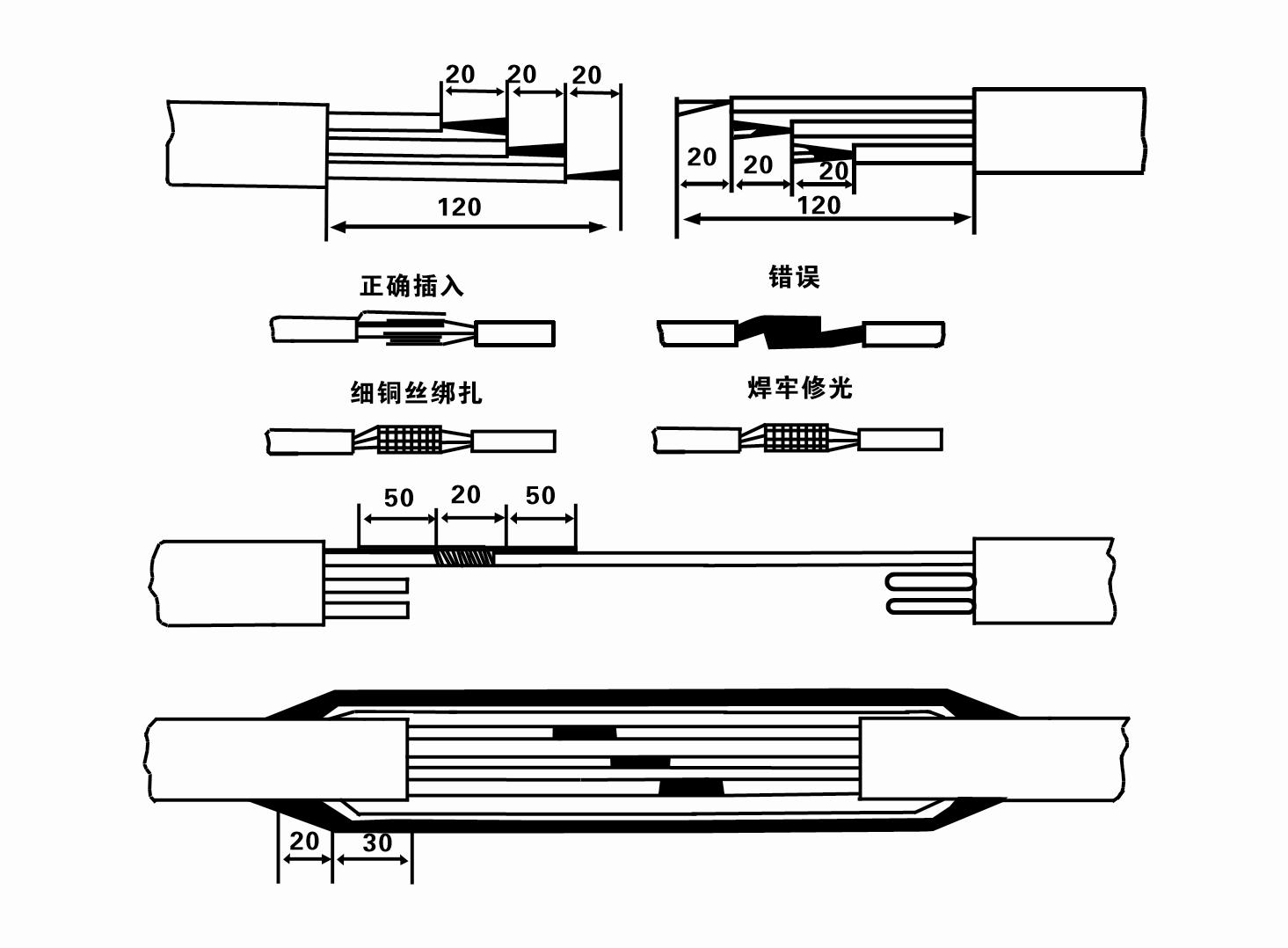
8. Gunakan multimeter untuk memeriksa sama ada wayar tiga fasa disambungkan dan sama ada rintangan DC adalah lebih kurang seimbang.
9. Periksa sama ada kapasiti litar dan pengubah telah terlebih beban, dan kemudian sambungkan suis perlindungan beban lampau atau peralatan permulaan. Lihat Jadual 2 untuk model tertentu, dan kemudianTuangkan baldi air ke dalam pam air dari alur keluar pam air untuk melincirkan galas getah dalam pam, dan kemudian letakkan pam elektrik tenggelam tegak dan stabil. Mula (tidak lebih dari satu saat) dan semak sama ada arah stereng adalah konsisten dengan tanda stereng. Jika tidak, tukar mana-mana dua penyambung kabel tiga fasa. Kemudian pasang penapis dan bersedia untuk turun ke dalam telaga. Jika digunakan dalam majlis-majlis khas (seperti parit, parit, sungai, kolam, kolam, dll.), pam elektrik mesti dibumikan dengan pasti.
(2) Peralatan dan alatan pemasangan:
1. Sepasang rantai angkat untuk lebih daripada dua tan.
2. Tripod dengan ketinggian menegak tidak kurang daripada empat meter.
3. Dua tali gantung (tali dawai) yang boleh menanggung berat lebih daripada satu tan (boleh menanggung berat set lengkap pam air).
4. Pasang dua pasang pengapit (splints).
5. Sepana, tukul, pemutar skru, alatan dan instrumen elektrik, dsb.
(3) Pemasangan pam elektrik:
1. Gambar rajah pemasangan pam elektrik tenggelam ditunjukkan dalam Rajah 2. Dimensi pemasangan khusus ditunjukkan dalam Jadual 3 "Senarai Dimensi Pemasangan Pam Elektrik Rendam".
2. Pam elektrik tenggelam dengan kepala kurang daripada 30 meter boleh dinaikkan terus ke dalam telaga menggunakan hos dan tali dawai atau tali rami lain yang boleh menanggung berat penuh keseluruhan mesin, paip air, dan air dalam paip.
3. Pam dengan kepala lebih daripada 30 meter menggunakan paip keluli, dan urutan pemasangan adalah seperti berikut:
①Gunakan pengapit untuk mengapit hujung atas bahagian pam air (motor dan pam air telah disambungkan pada masa ini), angkatnya dengan rantai gantung, dan ikat perlahan-lahan ke dalam perigi sehingga Letakkan pengapit pada kepala perigi dan keluarkan rantai gantung.
② Gunakan sepasang pengapit lain untuk mengapit paip, angkat dengan rantai gantung 15 cm dari bebibir, dan turunkannya perlahan-lahan. Antara bebibir paip dan bebibir pamLetakkan pad getah pada tempatnya dan ketatkan paip dan pam sama rata dengan bolt, nat dan pencuci spring.
③ Angkat sedikit pam tenggelam, keluarkan pengapit di hujung atas pam air, ikat kabel dengan kuat pada paip air dengan pita plastik, dan ikat perlahan-lahan sehingga Pengapit diletakkan di kepala telaga.
④Gunakan kaedah yang sama untuk mengikat semua paip air ke dalam telaga.
⑤Selepas kabel plumbum disambungkan ke suis kawalan, ia disambungkan ke bekalan kuasa tiga fasa.
(4) Perkara yang perlu diberi perhatian semasa pemasangan:
1. Jika fenomena jamming ditemui semasa proses mengepam, pusing atau tarik paip air untuk mengatasi masalah jamming point. Jika pelbagai langkah masih tidak berkesan, silaJangan paksa pam ke bawah untuk mengelakkan kerosakan pada pam elektrik tenggelam dan telaga.
2. Semasa pemasangan, pad getah hendaklah diletakkan pada bebibir setiap paip dan diketatkan sama rata.
3. Apabila pam air diturunkan ke dalam telaga, ia harus diletakkan di tengah-tengah paip telaga untuk mengelakkan pam daripada berjalan di dinding telaga untuk masa yang lama, menyebabkan pam bergetar dan motor menyapu dan terbakar. .
4. Tentukan kedalaman pam air ke dasar telaga mengikut keadaan pasir dan kelodak telaga yang mengalir. Jangan tanam pam di dalam lumpur. Jarak dari pam air ke dasar telaga biasanya tidak kurang daripada 3 meter (lihat Rajah 2).
5. Kedalaman kemasukan air pam air hendaklah tidak kurang daripada 1-1.5 meter dari paras air dinamik ke nod salur masuk air (lihat Rajah 2). Jika tidak, galas pam air mungkin mudah rosak.
6. Lif pam air tidak boleh terlalu rendah. Jika tidak, injap pintu perlu dipasang pada saluran paip air kepala telaga untuk mengawal aliran pam pada titik aliran berkadar untuk mengelakkan motor daripada terlebih beban dan terbakar akibat kadar aliran yang besar.
7. Apabila pam air sedang berjalan, keluaran air hendaklah berterusan dan sekata, arus harus stabil (di bawah keadaan kerja yang diberi nilai, secara amnya tidak lebih daripada 10% daripada arus undian), dan tidak sepatutnya ada getaran atau bunyi. Sekiranya terdapat sebarang kelainan, mesin hendaklah dihentikan untuk mengetahui punca dan menghapuskannya.
8. Apabila memasang, perhatikan tetapan wayar pembumian motor (lihat Rajah 2). Apabila paip air adalah paip keluli, bawa ia dari pengapit kepala telaga; apabila paip air adalah paip plastik, bawa ia dari tanda pembumian pam elektrik.
After the installation of the underwater pump, the insulation resistance and three-phase continuity of the switch face should be rechecked, and the connection between the instrument and the start device should be checked for any errors. If there is no problem, you can start to test the machine. After the start, observe whether the indication readings of each instrument are correct. If the rated voltage and current specified on the nameplate are exceeded, observe whether the pump has noise or vibration. If everything is normal, it can be put into operation. After the first operation of the pump for four hours, the motor should be shut down and tested for thermal insulation resistance quickly. Its value should not be less than 0.5 megaohm. After stopping the pump, it should be restarted after an interval of five minutes to prevent the water column in the pipeline from completely reversing and causing the motor to burn out due to excessive current. After the pump is put into normal operation, in order to prolong its service life, it is necessary to check regularly whether the supply voltage, running current and insulation resistance are normal. If the following conditions are found, the machine should be shut down immediately to eliminate the fault: the current exceeds 20% under rated working conditions; the dynamic water level drops to the inlet section, resulting in intermittent drainage; the underwater pump becomes violently vibrating or making noise; the supply voltage is lower than 340 volts; a fuse is blown out; the water pipe is damaged; the motor's thermal insulation resistance to the earth is less than 0.5 megaohm. The sequence of disassembly is: untie the cable fastening, remove the pipeline part, remove the line protection plate, screw down the water discharge bolt and discharge all the water in the motor chamber, remove the filter and loosen the coupling fixing screw of the motor shaft. The sequence of disassembly of the pump is: (see Figure 1) inlet section, impeller, guide housing, impeller, check the valve body. When removing the impeller, use special tools to loosen the taper sleeve of the impeller. Avoid bending the pump shaft and damaging the components throughout the process. The disassembly process of the motor is: (see Figure 1) put the motor on the platform, and remove the bolts, base, shaft head lock nut, thrust plate, key, lower guide plate (transverse bolt), bearing seat, screw knife seat from the bottom of the motor in order (take care not to damage the winding), and finally remove the connecting part and the upper guide bearing seat. Before assembling the unit, the rust and dirt of each part should be cleaned, and the sealant should be applied to each mating surface and fastener, and then assembled in reverse order of disassembly (the movement of the motor shaft after assembly is about one millimeter). After assembly, the coupling should be rotated flexibly and put on the filter for test. Once a year, or if less than a year of operation but has been immersed for two years, the underwater electric pump must be disassembled for maintenance in accordance with Article 5 and replace worn parts to ensure the normal operation and durability of the pump.
1, keluarkan air dalam rongga motor (terutama pada musim sejuk untuk mengelakkan motor daripada membeku), dan ikat kabel dengan baik.
2, store in an indoor room without corrosive substances and gases, with a temperature below 40 °C.
3, penggunaan jangka panjang perlu memberi perhatian kepada pencegahan karat pam tenggelam.
- Pendesak
- Lengan aci
- Lengan aci getah
-
Cincin pengedap
01 Pengambilan air perigi dalam
02 Bekalan air bertingkat tinggi
03 bekalan air gunung
04 air menara
05 Pengairan pertanian
06 pengairan taman
07 pengambilan air sungai
08 air domestik

